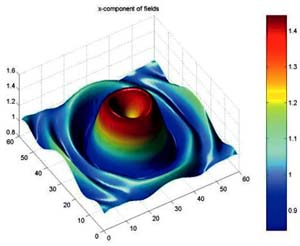| 2004 |

|
YEAR BOOK |
Dublin City University
|
Electromagnetic wave modelling in the School of Electronic Engineering
|

Specifically, our group has significant expertise in UHF (Ultra High Frequency) wave propagation modelling for use in wireless system planning. We model such propagation using a variety of cutting-edge techniques, such as ray tracing and parabolic and integral equations. We have much experience in related problems also, such as transmitter position optimization and algorithms for locating mobile users within, for example, a wireless LAN (Local Area Network). We have also worked extensively in the area of acceleration algorithms for integral equation analysis of scattering problems such as arise in radar cross-section computation or interconnect analysis. These acceleration algorithms can reduce the computation time for such problems from hours or days to minutes or even seconds with no discernible loss in accuracy.
The illustration shows the results of one such simulation. A plane wave impinges on a metallic plate producing reflected and diffracted fields. The diagram shows these scattered fields as computed using an efficient computational technique developed by members of our group.
Our group has also worked extensively in the area of efficient time and frequency domain analysis of high frequency circuits, both linear and non-linear. The emphasis has been on reduced order modelling � the development of sophisticated algorithms that can greatly reduce the computational complexity of the analysis, thereby greatly speeding up the design and simulation of massively complicated circuits.
Contact: Dr Conor Brennan, RINCE, School of Electronic Engineering, DCU;
Tel: + 353 1 700 7649; E-mail: [email protected] ;
Dr Marissa Condon, RINCE, School of Electronic Engineering, DCU; Tel: + 353 1 700 5405; E-mail: [email protected] ;
Web: http://www.eeng.dcu.ie/~rfmodsim